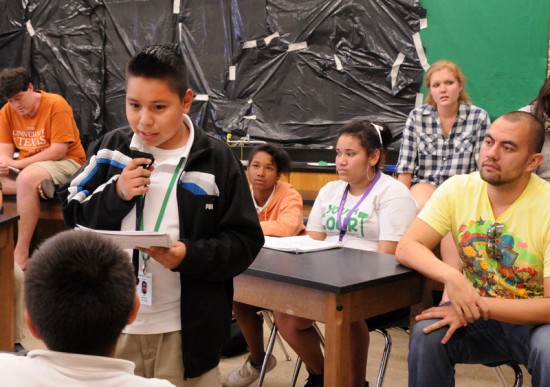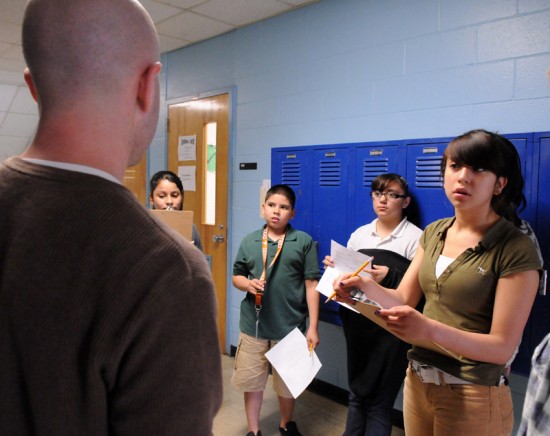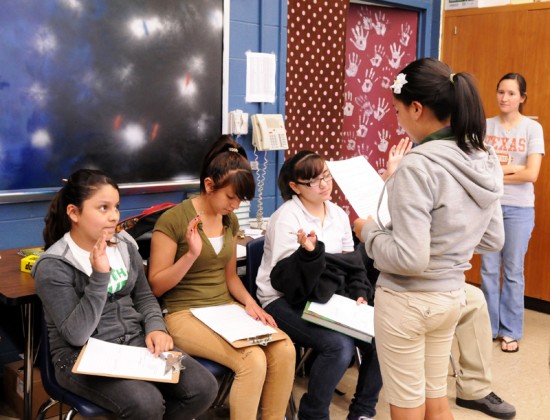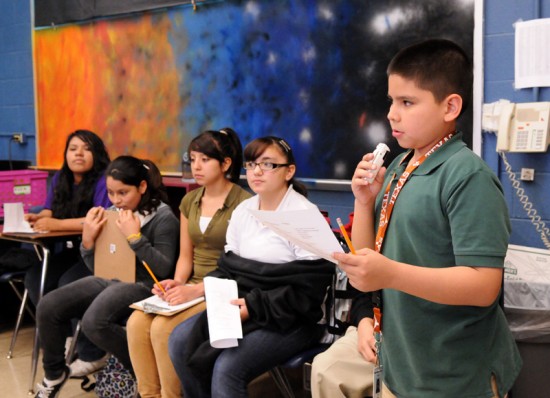Five days a week at Webb Middle School in North Austin, a handful of the sixth-, seventh-, and eighth-graders spend a class period as prosecutors, defense attorneys, jurors, judges, and defendants. These middle-schoolers are trained in their roles, and assisted in parts of the process, by students at the Law School, who help them frame their arguments, deliberate, and raise objections. And while this sounds like most other mock trial programs, there’s one crucial difference between what happens at Webb’s Youth Court and what happens in mock trials at most other schools. Here, the consequences are real, and the stakes can be surprisingly high.
The Youth Court trial held at Webb on March 25, 2011, involved a seventh-grade girl who had been caught skipping an assigned tutoring session and hiding on school grounds with a male student. The charges against her were for lying to her mother and skipping school, and the session began with the bailiff—a boy in a Youth Court T-shirt—swearing in the jury, before all present rose, and the judge entered the classroom. It was made clear that the purpose of Youth Court was not to determine guilt or innocence, but to decide on the appropriate consequences for the defendant’s actions, and both sets of attorneys made their recommendations. The defendant took the stand and faced cross-examination, and the prosecution read testimony from some of the girl’s other teachers, which they obtained by interviewing those teachers prior to the trial. The jury heard the evidence, left the room to deliberate, and returned a few minutes later, outlining the consequences that the student defendant would face: a letter of apology to her mom, making up the missed tutoring session, participation in a “healthy relationships” program at the school, and the assigning of a Law School mentor who would help monitor her progress. Case closed, the bell rang and the session ended.
If it all sounds cute—and it was, to some extent—there’s also a serious component here. According to April Scofield, the Webb science teacher who oversees the school’s participation in Youth Court, the girl in question could have faced much harsher consequences if it hadn’t been for the program. “By the time we get them, they’ve had repeat offenses, and what we’re trying to do is keep them out of the Alternative Learning Center,” a disciplinary institution for students who have been removed from their regular school. She explained, “It may not seem severe, but it’s cumulative, and the accumulation of all the things that a defendant has done could eventually result in being sent to the ALC.”
At its most basic level, Youth Court is meant to address the school-to-prison pipeline, the growing national trend where children are removed from classrooms or public schools and set on a path leading into the criminal justice system. With the rise of zero-tolerance policies on campuses, the turning over of classroom discipline to police, and the widespread practice of issuing Class C misdemeanor tickets inside the school walls for behavior that wouldn’t be criminal in other aspects of life, finding new ways to enforce disciplinary infractions is a topic of great importance to a number of educators—and to Law School students and faculty with experience in the education system. But what’s most critical to know about Youth Court is that it’s not just an exercise that some middle-school teachers and volunteers from the Law School have come up with in the hope that they can right a system that seems to be in need of some serious reconsideration. What’s most critical to know about Youth Court is that even in its first year, it appears to be making a positive impact.
Youth Court came to the Law School last year, under the direction of Professors Sarah Buel and Norma Cantu, who had been teaching a class on education policy. Buel moved on to the Arizona State University Sandra Day O’Connor College of Law, and Professor Tina Fernandez stepped in as faculty advisor for Youth Court. “In the class, law students read about the school-to-prison pipeline,” Fernandez said, “And they learned about youth courts, which have been used as a diversion model in high schools. The students, and Professor Buel, got very excited about it. They thought starting it in middle school would be a good idea, because that’s where kids really start to get on the wrong track.”

The prosecuting attorney cross examines his witness while Meredith Elkins, ’13, Michael Muna, ’13, and other Youth Court members listen.
The current program is overseen by Fernandez, who directs the Law School’s Pro Bono Program out of the William Wayne Justice Center for Public Interest Law, as well as students Meg Clifford, ’12, and Christine Nishimura, ’12. All three women are former educators who’ve worked with Teach For America, and they say that the perspective they gained in the classroom helped them immediately understand the importance of the program. “The program is essentially a continuation of Teach For America’s mission, which is that, no matter what avenue the alumni may choose or what industry you go into, you remain an advocate for low income communities and an advocate for the education system,” Clifford explained. “In Austin, the school-to-prison pipeline is a thriving, real thing.”
Countering that pipeline is written into Youth Court’s stated goals, and while all of the evidence regarding its success is currently anecdotal, it’s nonetheless compelling. “There’s one student that we heard about who came through Youth Court, who they were having some real issues with,” Fernandez recalled, “And the vice principal told us that he’s had zero referrals since going through the program. The teachers comment on the fact that he’s done a better job in school and, in fact, he got recognized at a student assembly as the ‘student professional of the month.’ When he was on stage, he said that he had been waiting for that moment his whole life.”

The jury deliberates on the consequences they will assign the defendant in consultation with Jon Levy,’13.
So what is it that makes the Youth Court so effective at helping turn around students who are at risk of being suspended, sent to Alternative Learning Centers, or worse? April Scofield, faculty advisor of the program at Webb, has some ideas. Scofield, who’s in the midst of a master’s program in mediation, attributes the program’s successes to that most powerful of pre-teen forces: peer pressure.
During the cross-examination part of the trial, defendants are asked personal questions, and the prosecutors read testimony from teachers they’ve interviewed about the student’s behavior. “We’ve actually had students that have said, ‘I don’t want to go in there! Those are my friends!’ For this population,” Scofield explained, “That social aspect is important. They don’t want to be talked about. And when you get sent to Youth Court, your stuff is put out there. They care more about what their friends think than what adults think.”
There’s another important aspect to Youth Court, as well. For young people, especially of middle-school age, the nature of power and authority seems arbitrary. Adults, especially teachers, have it; they do not. Fernandez explains that the Youth Court system helps change the students’ relationship with authority. “There’s something to be said about the model in which they’re being adjudicated by peers. It’s another child, one of their peers, really calling them out publicly. Sometimes one of the lawyers will turn to the defendant and say, ‘Why did you say that? What else could you have done?’ And from our preliminary data, you can really see that there is at least some short-term self-reflection.”
Scofield concurrred with Fernandez. “A big thing for our kids is fairness. The defendant might say, ‘Well, I don’t do work in her class because she isn’t fair to me.’ This idea of fairness is big to them, but they also have a skewed perception of fairness. This helps them understand that just because it’s fair doesn’t mean you’re going to like it.”
For the students involved—both the Law School students and the Webb Middle School students—there are benefits to being involved in Youth Court that go well beyond the actual trials they hold. For the middle-schoolers, it gives them an opportunity to form a relationship with adults who aren’t teachers. “For a lot of our kids, adults are the enemy, because so many adults have abandoned them, or have not done anything for them,” Scofield said. But the law students occupy a different role. “Slowly, as they start to see the same adult taking interest in them repeatedly, they really open up. I have students come up to me asking for specific law students. There’s a connection, and a bond, that’s happening. It excites them to see adults who aren’t teachers, who don’t have to worry about standardized testing.”
At the Law School, Meg Clifford sees another benefit for the first-year students for helping prepare the middle-schoolers for Youth Court, as opposed to mock trials at the Law School. “You have to be able to explain things so that a group of middle school kids can understand it. And if you can explain it to a thirteen-year-old, you can explain it to anyone,” she said. “So when considering your average juror in court, if you’re having a complicated legal issue, it helps you remember: ‘I have to break this down enough so that someone else understands what I’m talking about.’ It helps them understand how to question people, and get people to think to that next level, especially when it comes to trial skills. It’s really beneficial to law students. There’s no better way of learning than having to teach.”
For Clifford, Nishimura, and Fernandez, however, the benefits of working with the students at Webb extend beyond the practical ones that might help a young lawyer prepare for trial. The three Teach For America alumni all agree: “If you were a teacher, and you loved teaching, then you need some kid time,” Clifford said. “It’s such a habit after working full-time with kids, so it’s great to go in at this middle school, and still have these relationships with kids. To still be working with them academically and socially—that part of it is fun. It’s something we’re good at.”
The middle-school students share their enthusiasm for working together. Sandra, a seventh-grader, lights up when talking about what she’s gained from Youth Court. “It’s fun! I really like it. If I ever want to be a lawyer, I have a head start to it.” She paused for a moment, then added. “I probably will be a lawyer in the future.”
That sort of aspiration seems common among Youth Court participants, too. Scofield estimates that about half of the students involved in the program have mentioned pursuing a career in law to her. And even if that’s not the path that they end up taking, seeing themselves in the roles of lawyers and judges is an empowering thing for a young person. “It’s a big deal,” Fernandez said. “They take it very seriously. The lawyers have to go interview the teachers to get evidence, and the overwhelming majority of the feedback we get from the teachers is that they approach it very professionally. They get a chance to have some power in their school that they may not have ever experienced before.”
That element—having power in their own school—is at the core of what makes Youth Court work not just for the defendants and the adult advisors, but also for the participants who make up the pool of attorneys, judges, and jury members. The students were selected from a broad swath of the population at Webb, and, while they’re all on track to pass the TAKS Test, there’s a great deal of diversity among the students in terms of behavior, which Fernandez said was a goal of the program from the beginning. Every student in the program spends time in every role. For Youth Court participant Suleiva, her favorite part is that of the prosecution, because of how empowering it is.
“You have to give punishments, so they won’t do that same action again,” she said. “I think that’s right—they have to stand up for their actions.” Still, the seventh-grader is aware that the power she has in this setting is there for a good purpose. “I like to be here because you help other people. Sometimes, we all need help.”
For one student participant, an eighth-grader named Alejandro, that help has been a major part of his school year. While he’s never been a defendant, he identifies with the students who have. “I’ve been in trouble before, and I like to be here because it helps me change.” Scofield, who also teaches Alejandro in a science class, describes the effect it’s had on him as “incredible.” And that, ultimately, is the real potential of a program like Youth Court. In order to circumvent the school-to-prison pipeline, the students at the greatest risk of following that path need the opportunity to see themselves as something other than the “bad kids,” and Youth Court is all about providing that. Scofield says that the program is on the verge of putting together its first jury pool comprised entirely of former defendants, demonstrating that there’s more mobility in their lives than the students may have ever thought possible before.—Dan Solomon


